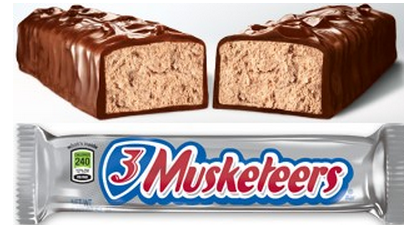Where the Other Two Musketeers Went

In anticipation of Halloween, FiveThirtyEight released its “Ultimate Halloween Candy Power Ranking,” an attempt to determine which fun-sized sweet door-hopping trick-or-treaters like the most. Unsurprisingly, Reese’s Peanut Butter Cups top the list, but some may be surprised to see 3 Musketeers come in at #12, between Peanut M&Ms and Starbursts. Pictured above (in full size), 3 Musketeers can be controversial — some people enjoy whipped nougat covered in a thin chocolate shell, but others prefer something with a little more going on. Regardless, it’s a staple of both Halloween and the candy aisle.
But it has a really weird name, right? There’s only one bar in a package and … musketeers? What does a chocolate bar have to do with the French military of the 1600s?
It’s complicated.
The 3 Musketeers Bar has been around since 1932, and originally, you’d get three pieces of chocolate for the price of five cents. (Great deal, right?) The idea was that you’d eat one yourself and share the other two with friends. The Mars company, which made the candy (and still does), compared the friendships you’d create with ones described 1844 novel titled “The Three Musketeers.” It’s a bit of a leap, sure. Yet, to a 1930s marketing department, it made sense, and that’s where the chocolate bar gets its name.
Today, though, we don’t get three pieces of chocolate for the price of one. That’s because of World War II.
The three pieces you used to get for that nickel came in different flavors. One piece had a fluffy, chocolaty inside like we have today. The other two, though, were different — one was vanilla and the other was strawberry. Mars expected each to be, roughly, equally popular, but that wasn’t what actually happened. The chocolate candy was more popular than the vanilla and the strawberry one, and noticeably so.
When World War II broke out, the government began rationing certain foods. Mars had to cut back on their offerings, and 3 Musketeers was one of the affected candies. Mars dropped the less popular flavors, going chocolate-only right around the time the war ended in 1945. In doing so, they also went from three bars to one, forever divorcing the name from the product. The 3 Musketeers has been one bar of chocolate fluff, covered in a chocolate candy shell, ever since.
Bonus fact: The Mars company gets its name from its founder, Frank C. Mars. Frank’s son, Forrest Mars, Sr., took over the company when Frank died in 1934. During World War II, Forrest partnered with the Hershey company in 1941 to create a new product because Hershey had access to rationed chocolate. The one they came up with is named after the last names of Forrest Mars and Hershey’s president at the time, William F. R. Murrie — M&Ms.
From the Archives: Brown Out: The surprisingly good reason that Van Halen insisted on not having brown M&Ms in their dressing room.
